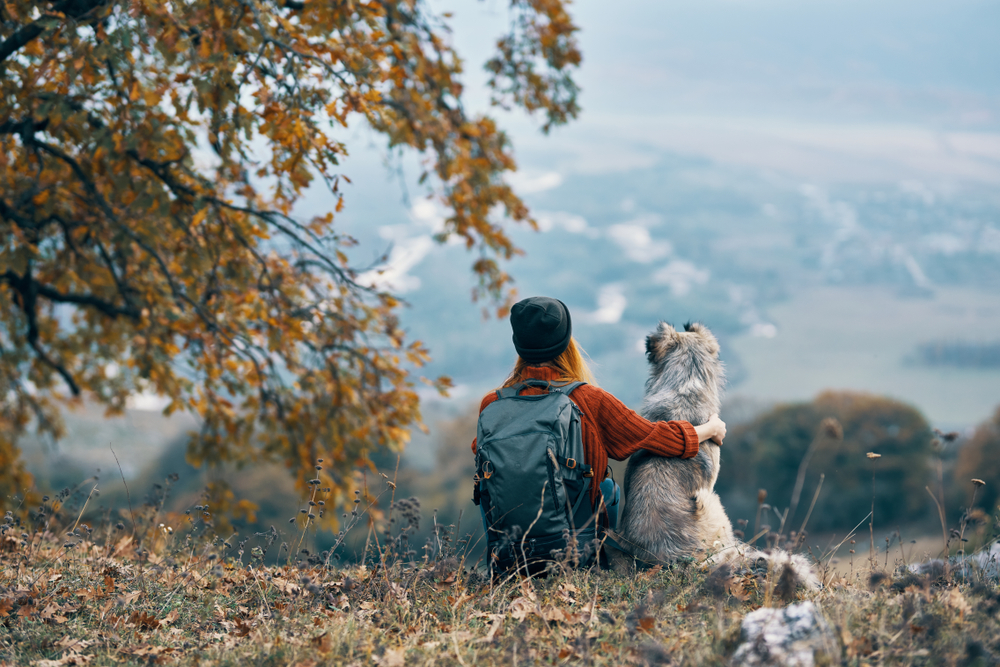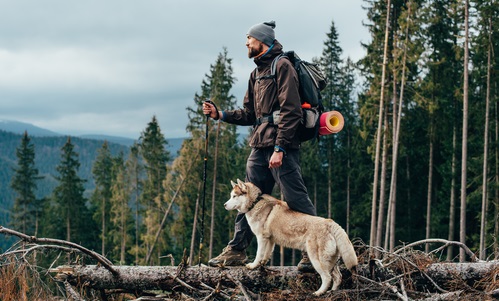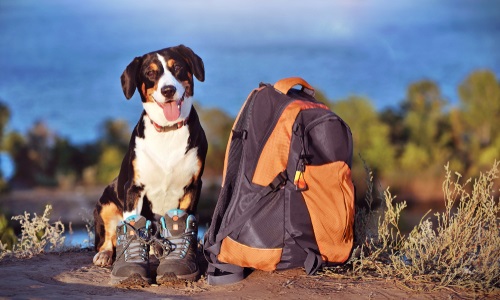You and your pup head out for another mountainous adventure—in one version of this story you have an amazing experience, taking selfies in front of lush vistas, enjoying summer treats for dogs, and rewarding good behavior with CBD dog treats.
In the other version, your pup growls and yowls from the parking lot to the vista, poops gigantically in the middle of the trail just as you realize you have no baggies, and then rips her leash out of your hand and vanishes into the underbrush after spotting a chipmunk rustling in the bushes.
To avoid the second scenario, preparation is key when hiking with your dog. In this guide, we’ve mapped out everything you need to know to hit the trail with your furry friend—you can set yourself up for backcountry success by learning basic trail etiquette for pets (and pet owners), understanding how your dog sees the great outdoors, and packing mindfully for both you and your pup.
What to Consider When Hiking With Your Dog
Hiking with your dog can be a marvelous and eye-opening experience for both you and your pup. 1But before taking a single step into the woods, you’ll need to know how to hike with your dog.
In other words, you need to be sure that your furry friend is capable of accompanying you on a hike. To determine whether hiking with your dog is a good idea, consider:
- Age – Puppies and senior dogs might want to hike, but that doesn’t mean that they should hike. For young dogs, you shouldn’t undertake sidewalk walking—let alone wilderness hiking—before they are fully vaccinated around 16 weeks. 2Even when they are fully vaccinated, you’ll need to hold off on strenuous hikes until their leg bones and growth plates are fully formed around one year old. Similarly, very old dogs might not have the strength, stamina, and immunity for a long hike. If your dog is seven years or older, tailor your outdoor activities to their health and consider supplementing their diet with joint maintenance products. The bottom line is, if you’re planning to hike with a puppy or a senior dog, check with your vet first to make sure your planned activity will suit them before you strike out into the wilderness.
- Breed – Certain breeds of dogs may struggle with anything more than a sidewalk stroll. Brachycephalic dogs (meaning those with a short snout) like Boxers, Pugs, Bulldogs, and Pekinese may not be able to get enough air into their relatively-small respiratory systems to keep up with you on a steep or fast hike. Similarly, dogs with high prey drive (hunting or birding dogs like Huskies, Labradors, and Terriers) or dogs with strong protective urges or low obedience levels might pose a danger in the backcountry.
- Fitness level – Although hiking is a great way for you and your canine companion to get into shape together, it’s wise to build up stamina slowly if this is a new enterprise. Before setting out, evaluate how fit your furry friend actually is.3 And as you undertake longer hikes, be mindful to watch for signs of fatigue such as:
- Excessive panting or difficulty breathing
- Unusual drooling
- Lack of urine
- Rapid pulse
- Muscle tremors
- Weather – Even if you and your pup are in top physical condition, always be mindful of the current and upcoming weather conditions. With a heavy fur coat, dogs can overheat much faster than you during the summer. On the other hand, winter hiking can be hard on smaller dogs and those with shorter coats. Lastly, you’ll want to be aware of any changing weather conditions as you head up the mountain. Afternoon showers are common at higher elevations—so if your pup is prone to being fearful of thunderstorms, you may want to save your hike for a clearer day.
Trail Etiquette for Dog Owners
Once you’ve decided that your dog is ready to begin hiking, you’ll need to work on their trail manners. And yours. The truth is, your dog doesn’t have manners—you do. Instead, your dog has behavior. When it comes to being a good trail citizen, it’s your etiquette that matters.
Learning the basic rules of the trail will enhance your experience. To that end, here are a few tips for hiking with a dog:
- Collar your dog with a sturdy collar that includes identification and contact information
- Leash your dog with a 6’ or shorter leash unless you know off-leash hiking is allowed
- Pick up and dispose of your dog’s poop or bring a small spade and bury it
- Yield to all other trail users, including hikers without dogs, horseback riders, and bikers
- Step off the trail and hold your dog on a short leash when passing another canine hiker
- Don’t allow your dog to sniff other trail users
- Announce your presence when approaching a fellow trail user from behind
Although some rules are universal, such as protecting the environment, others depend on the location of your hike. As such, research the pet-specific regulations for any new hiking spot you visit.
Additionally, while many local and state parks allow dogs, national parks usually have tighter rules. To that end, researching ahead of time to identify what is and what isn’t allowed on the park trails can make the experience better for everyone.
Packing for Your Pup
Depending on the length and strenuousness of your hiking itinerary, you’ll need to be mindful of packing for your pup as well as for yourself. There are two ways to pack for pooch:
- Carry supplies for both of you in a backpack.
- Train your dog to carry his own supplies. (Although this is a great ultimate goal, you should not expect your dog to understand his pack the first time you try it. As with all new hiking skills, start with a short hike and a light pack to build your pup’s stamina.)
No matter whether you carry all of your supplies or your pup shoulders some of the load, there are a few items you should bring for your pup on every hike:
- 8 ounces of water for every hour you intend to hike4
- Water bowl
- Treats, snacks, or a meal, depending on the length of the hike
- Poop disposal bags or a small spade for burying waste
- Canine first-aid supplies including bandages, gauze, bandanas, small scissors, hydrogen peroxide, an extra sock, and tweezers
- Small flashlight, collar light, or lighted leash, even if you intend to return before dusk
Additional supplies that can enhance your expedition are:
- CBD dog treats if your pup tends to get achy joints or anxiety
- Booties if they have tender paws
- Reflective clothing if you plan to be out after dark
- Warm clothing if your pup tends to get chilled easily
Safety Considerations
Not only do you need to take comfort supplies into consideration for your pup, but you also need to be aware of and prepared for additional safety issues when bringing your dog into the backcountry, such as:
- Snakes and wild animals – Even leashed dogs can come across a wild new friend. Staying alert to those you share the outdoors with will prevent mishaps. Watch your feet and the brush surrounding the trail closely and look for cues from your pup, and never allow them to interact with wild animals.
- Other dogs – Learning to pass other dogs without reacting is a top dog skill. Nothing is worse than pulling apart two dogs on a narrow, steep trail.
- Hunters and traps – Allowing your pup to run unleashed may seem like lots of fun, but be sure the area you are hiking in isn’t being used for hunting or trapping.
- Poisonous plants – Just because you wouldn’t eat a strange brown lump on the trail doesn’t mean your pup won’t. Know the local poisonous plants in your hiking area and keep your dog away if you come across one.5 Some of the most common wild plants that can be poisonous to dogs are:
- Black walnut
- Hickory
- Milkweed
- Acorns
- Tansy flowers
- Yarrow
- Buttercups
- Jimsonweed
- Holly
- Sago palms
Also be aware that your pup can pick up the oils from plants that might be poisonous to you (like poison oak, poison ivy, and poison sumac) and then inadvertently pass it along through their fur.
- Water – Water in the backcountry can be a real problem. From drowning risks to bacterial infections, you need to keep your canine hiking companion away from water. While it’s clear that your dog shouldn’t swim in quickly moving water or walk across a frozen pond, even drinking shallow, stagnant water can be dangerous as it can lead to intestinal distress, bacterial infection, or vomiting.
How To Make the Most of Your Hike
Once you’ve trained your pup, checked with your vet, supplied your backpack, and settled on a first hike, there’s nothing more to do than head out into the wild. Here are a few of our top tips to help you optimize your adventure:
- Start small – If you or your dog are inexperienced when it comes to hiking, start with short hiking trails that don’t gain a lot of elevation before leveling up to longer or more arduous hikes.
- Keep it fun – Bring a ball or a frisbee with you to entertain your pup once you’ve reached your destination. Or choose a hike with an exciting endpoint, such as a lake where your dog can cool off.
- Be aware of your surroundings – Depending on where you live, you may encounter some wildlife. As such, always be aware of your surroundings and don’t let your pup stray too far.
- Let your dog set the pace – Dogs typically won’t exert themselves past what they’re capable of. As such, let your dog lead the way to avoid them over exhausting themselves.
- Add a tasty treat – A full-spectrum CBD treat may be just what your pup needs to make it that final mile—CBD may boost your pup’s mood and may help relieve any joint pain during the hike.
Go the Extra Mile With Canna-Pet
Whether you’re a new hiker or a seasoned pro, bringing your pet into the great outdoors presents you with an opportunity to get outside and bond with your pup. Once you’ve read up on local regulations, packed accordingly, and considered any safety concerns, you should be good to trek into the great unknown.
At Canna-Pet we want to support your journey with the highest quality natural and nutritional CBD dog treats and products. Our organic CBD treats are just the thing for pets with achy joints or nervous dispositions. If you have a companion who prefers the indoors, check out our ideas on how to keep your cat cool in the summer.
Sources:
- International Journal of Environmental Research and Public Health. I Walk My Dog Because It Makes Me Happy: A Qualitative Study To Understand Why Dogs Motivate Walking and Improved Health. https://www.ncbi.nlm.nih.gov/labs/pmc/articles/PMC5580638/
- PetMD. When Can a Puppy Go Outside? https://www.petmd.com/news/view/when-can-puppy-go-outside-37926
- Animals. Perception of Body Condition, Diet and Exercise by Sports Dog Owners and Pet Dog Owners. https://www.mdpi.com/2076-2615/11/6/1752/htm
- American Hiking Society. Gear for Hiking with a Dog. https://americanhiking.org/resources/gear-for-hiking-with-a-dog/
- Popular Science. 8 Common Wild Plants That Are Poisonous to Dogs. https://www.popsci.com/8-common-wild-plants-that-are-poisonous-to-your-dog/






